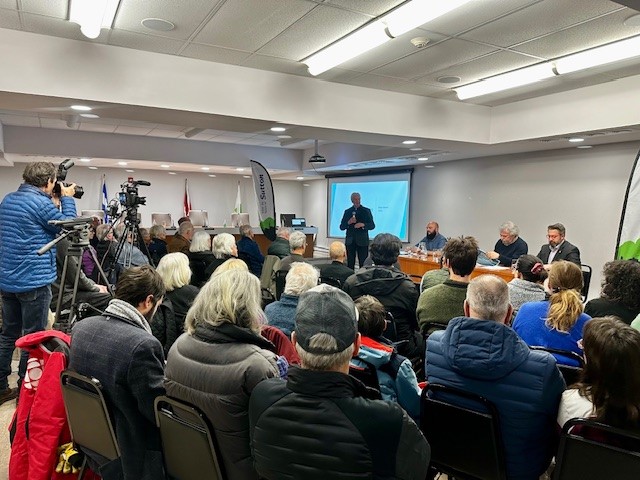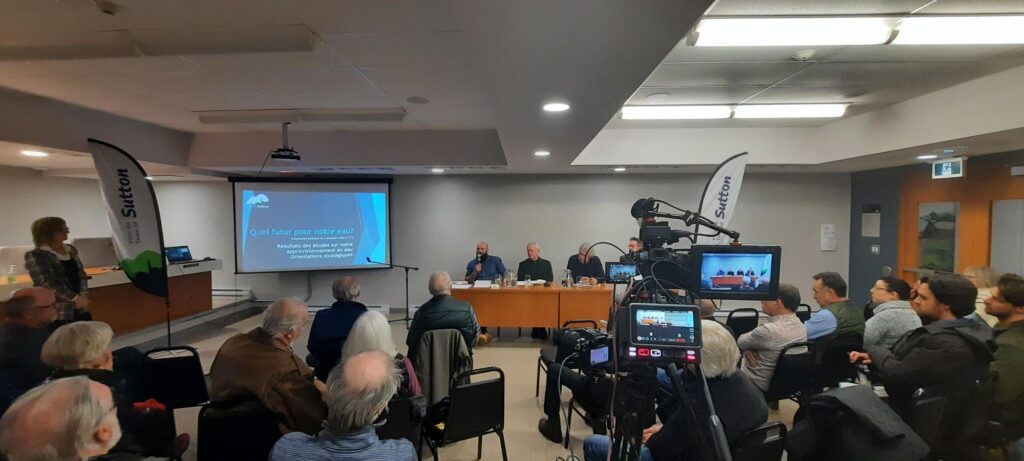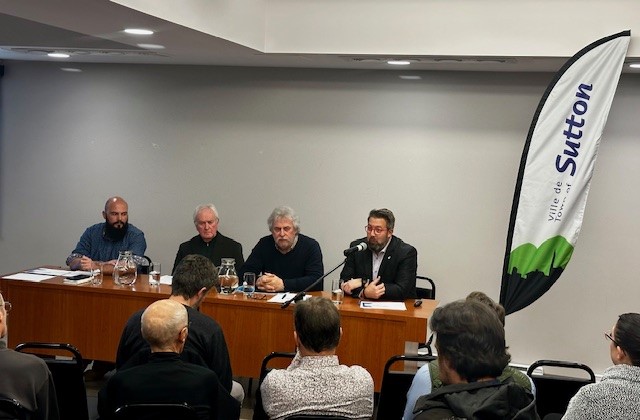Plenty of drinking water, but a resource to be protected!
On Tuesday, December 5, the Town of Sutton held a press conference and public presentation in the presence of some 50 people to announce the results of studies carried out on the drinking water supply in the village and on the mountain.

– PRESS RELEASE –
Sutton has almost six (6) times more water than it currently consumes, and that’s just from the village’s water table! Added to this is the strong likelihood that there is even more in the southern part of the village. This is what emerges from the studies that the Town has carried out over the past year on its water supply, both in the village and in the mountains.
“This is excellent news for all the citizens of Sutton,” enthused Mayor Robert Benoît. “The population can now be reassured: Sutton has substantial drinking water resources. However, this is no reason to waste this wealth, and we must increase our personal and collective efforts to better consume and protect it.”
Very reassuring figures
The studies that confirmed these results were part of the measures announced in the Town’s April 2022 action plan to protect its water, following an alarming report of water shortages in the mountains. LNA, a company specializing in hydrogeology and the environment, carried out a study to determine the recharge capacity of the water table that currently supplies the Academy well. Another study, entrusted to SNC Lavalin, confirmed the absence of underground water reserves in the mountain, thus eliminating any hope of finding other sources of supply in the area.
The resulting data are extremely positive :
- With a current average flow of 600 m3 of water per day, the Academy well can safely supply up to 3 times more, or 1838 m3 per day;
- By adding and connecting a second well near Route 215 (as recommended in the report), a safe and prudent supply can go up to 5.5 times more, or 3300 m3 per day. This investment would also secure the village’s water supply, which currently depends exclusively on the 40-year-old Academy well.
- The extra water available would feed the mountain area’s water supply network, relieving it of a significant number of homes.
Solutions for the short, medium and long term
“Now that we have this data, we can make informed decisions,” commented the mayor. “We’re moving towards a two-phase strategy that will protect our water supply in the long term while allowing for sustainable development of the village and the mountain.”
In the short term, the Town will reassess the scope and duration of the Interim Control By-law (RCI) that it and the Brome Missisquoi MRC imposed in 2022. Of course, the RCI will continue to apply to new homes until the projects mentioned below have been financed, built and put into operation. Water availability in the mountains, particularly in the Maple sector, is still not sufficient to supply new construction. On the other hand, in the Academy sector, which is served by individual wells, it would be possible to relax some of the RCI’s more restrictive zoning and subdivision measures, provided that the natural recharge of water to the village’s water table is preserved.
In the medium term, the addition of drinking water distribution capacity on the mountain could be considered progressively with a first phase.
Phase 1
✓ Installation of 2,350 m of pipeline and 3 booster pumps under Maple Street;
✓ Servicing of 258 homes currently served by the mountain network;
✓ Estimated cost between $7 million and $10 million, to be confirmed by an engineering study.
In the long term, depending on the development and densification orientations adopted as part of the urban plan review, a second phase could be considered.
Phase 2
✓ Installation of 1,200 m of additional pipeline, 1 additional booster pump and 1 reservoir at the top of Chemin Boulanger;
✓ Servicing of 741 additional homes currently served by the mountain networke;
✓ Estimated cost: $10 million, to be confirmed by an engineering study.
In total, the completion of these two phases would, together, relieve the mountain network by withdrawing nearly 1,000 housing units and 5 commercial establishments from the mountain sector, using water from the village. Taking into account current consumption of 600 m3 in the village, a total of 1,069 m3 of water per day would be required to meet these additional needs, i.e. a drawdown of only 58% from the Academy well, or only 32% from the two wells combined (Academy and new well on Route 215): very reassuring figures!

Immediate action
On the strength of all this information, the Town of Sutton intends to launch the study process for the technical and financial realization of a second well in the village as early as 2024. At the same time, it will initiate the engineering studies required for the construction of new pipelines and booster pumps, in line with the plans for phase 1. It will also initiate financing procedures for these new infrastructures. In addition, a review of the urban plan, zoning and subdivision by-laws, including extensive public consultation, will begin in 2024, and will be timely in measuring the social and economic impact of the potential addition of new residential and commercial units to the mountain.

The mayor of Sutton concludes: “We have acted with prudence and caution in this matter so as not to jeopardize the groundwater’s recharge capacity for future generations. Now that we have the assurance of its magnitude and the likelihood that it will be even more imposing, we can calmly undertake a public discussion on an acceptable level of development for Sutton that will preserve our exceptional quality of life.”
To listen to the Recorded presentation on the Town’s YouTube Channel
Link to the Expert reports on the supply of drinking water in Sutton
Link to the Public Presentation of December 5, 2023 – What does the future hold for our water?
Press Release – Plenty of drinking water, but a resource to be protected 2023-12-05
